|
ABOUT
DUCK FAT
Duck
fat contains 35.7% saturates, 50.5% monounsaturates
(high in linoleic acid) and 13.7% polyunsaturated
fats.(which contains Omega-6 and Omega-3 essential
oils). This compares to olive oil which is:
75% monounsaturated fat (mostly oleic acid)
13% saturated fat and 10% Omega-6 linoleic acid
and 2% Omega-3 linoleic acid. The main difference
between chicken, turkey and duck is that duck
contains more linoleic acid, which chicken and
turkey contain a higher amount of polyunsaturated
fats --- Read
more about Health Benefits of Duck Fat
A
comparison of the two methods for How to Make
Duck Fat
| METHOD I: BOILING
THE FAT IN WATER |
|
METHOD II: RENDERING
THE FAT WITHOUT WATER |
| |
|
|
| Remove the fat from the duck.
|
|
Remove the fat from the duck.
|
| |
|
|
| Chop the fat into very small
pieces |
|
Chop the fat into very small
pieces |
| |
|
|
| Add the fat to
a frying pan and spread out to cover |
|
Add the fat to
a frying pan and spread out to cover |
| |
|
|
| Cover the fat with water |
|
Cook on a low flame allowing
the fat to melt |
| |
|
|
| Cook on a medium flame allowing
the fat to render into the water |
|
As fat renders spoon off into
a bowl |
| |
|
|
| Continue to cook until the
water has evaporated and only a slight simmer
is visible |
|
Continue cooking till most
of the fat has been rendered |
| |
|
|
| Filter off the duck fat reserving
the remain fat for cracklings |
|
Filter off the duck fat reserving
the remain fat for cracklings |
| |
|
|
| Store overnight in the refrigerator |
|
Store overnight in the refrigerator |
|
|
COMPARISON
OF THE TWO METHODS
The
two methods were compared: 300 grams of diced
fat were added to two separate frying pans.
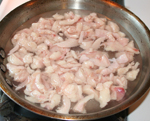 |
|
The duck fat is covered
with water. |
|
|
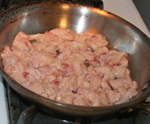 |
|
The duck fat is rendered
directly from the pan...removing the
liquid as it becomes available. |
|
| |
|
|
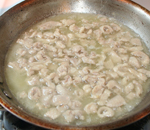 |
|
The fat is slowly rendered
into the water. Any discoloration
is prevented since the temperature
remains near 212F |
|
|
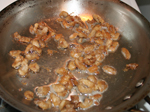 |
|
The remaining amount
of fat is stored separately or discarded
if it appears too oxidized. |
|
| |
|
|
| |
|
|
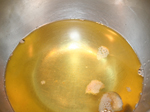 |
|
The collected unfiltered oil is
clear... there is no presence of
water.
|
| |
|
|
|
|
| |
|
|
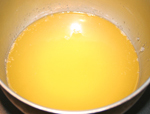 |
|
The collected oil is slightly cloudy,
possibly a result of retaining water
|
| |
|
|
|
| |
|
|
|
Both methods provide
for cracklings
|
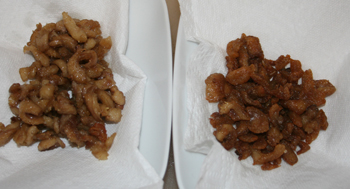 |
| |
|
|
Cracklings can
be stored in the freezer. It is
best to still have fat left in them.
Then, simply take them from the
freezer right into the pan for the
final crisp.
|
|
|
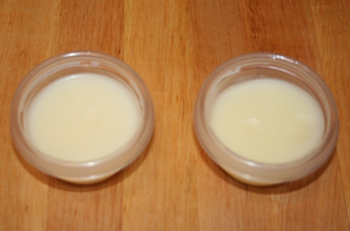 |
|
After refrigeration
the duck fat that is rendered using
Method II has a softer consistency
most likely a result of the presence
of water. (See below)
|
To see if the cloudiness during preparation
and the softer texture of the fat was
due to water retention we calculated the
density
for both fats preparations.
|
|
DENSITY METHOD I = 0.906 G/CM3
This value is consistent with most fats
and oils.
|
|
DENSITY METHOD II = 0.946 G/CM3
This value indicates the presence of
water.
Note: the density of butter can vary
between 0.911 and 0.95 depending on amount
of water.
|
Pros
and Cons for each method -- How to make Duck
Fat--
Method
I provides for a clearer more pure form of duck
fat. Method II retains water which can decrease
shelf-life. In addition Method II requires constant
watching during the rendering process. However
for small amounts of duck fat Method II is preferred.
Note:
Duck
fat which may contains water should not be added
to a very hot pan since the fat may splatter.
Add to a low heat pot and allow the sizzle to
die down first.
See
also a YouTube Video on rendering fat using
Method II---- You
Tube video on how to render fat
|

